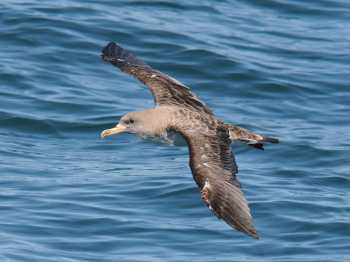Hansy Alonso (Marine and Environmental Sciences Centre, Lisbon, Portugal) and colleagues have published in the journal Progress in Oceanography on the fish diet of Cory’s Shearwaters Calonectris borealis (Least Concern) from the Selvagens.
The paper’s abstract follows:
“The distribution of many marine organisms is still poorly understood, particularly in oceanic regions. Seabirds, as aerial predators which cover extensive areas across the oceans, can potentially be used to enhance our knowledge on the distribution and abundance of their prey. In this study, we combined tracking data and dietary data from individual Cory’s shearwaters Calonectris borealis (n = 68) breeding in Selvagens archipelago, Madeira, Portugal, during the chick-rearing periods of 2011 and 2016, in order to infer prey origin within shearwaters’ main foraging areas. The digestion state of each prey item in the diet was assessed and classified; and compared to digestion states from known prey items fed to captive birds. In a novel approach, we combined tracking data with information on the prey digestion duration and data on the transit times from foraging grounds to the colony to estimate the location of prey capture. We found a consistent heterogeneity in prey distribution across four different marine domains: Selvagens, deep-sea, seamounts, and continental shelf. In oceanic areas, the chub mackerel Scomber colias, the main prey of Cory’s shearwaters, was strongly associated with seamounts and insular shelves, whereas oceanic species like pilot-fish, flying-squid, flying-fish were clearly associated with deep-sea waters. Sardines Sardina pilchardus, anchovies Engraulis encrasicolus and other coastal species were associated with the African shelf. Prey origin assignment was robust across three different sets of assumptions, and was also supported by information on the digestion state of prey collected over a large independent sampling period (671 samples, collected in 2008–2010). The integration of fine-scale dietary and foraging trip data from marine predators provides a new framework to gain insights into the distribution and abundance of prey species in poorly known oceanic areas.”

Cory's Shearwater, photograph by John Graham
Reference:
Alonso, H., Granadeiro, J.P., Dias, M.P., Catry, T. & Catry, P. 2018. Fine-scale tracking and diet information of a marine predator reveals the origin and contrasting spatial distribution of prey. Progress in Oceanography 162: 1-12.
John Cooper, ACAP Information Officer, 13 June 2018

 English
English  Français
Français  Español
Español